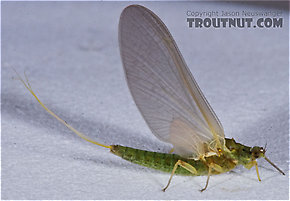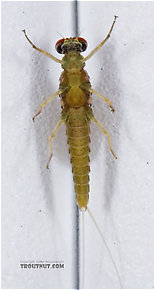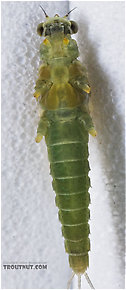Blog & Latest Updates
Fly Fishing Articles
Insects by Common Name


Mayfly Species Attenella attenuata (Small Eastern Blue-Winged Olive)
Taxonomic Navigation -?-
Kingdom
Animalia (Animals)
» Phylum
Arthropoda (Arthropods)
» Class
Insecta (Insects)
» Order
Ephemeroptera (Mayflies)
» Genus
Attenella
» Species attenuata (Small Eastern Blue-Winged Olive)
Common Names
I have several specimens listed under this species, but I'm not positive the identification is correct.
Where & When
This species begins to emerge in Pennsylvania in early June, and good hatches last through early July in the Catskills. In the Upper Midwest it continues into August.
Hatching Behavior
Time Of Day (?): Normally 9am to noon, but frequently in the evening during hot weather.
Habitat: Slow water
These mayflies emerge on the bottom of the stream and rise to the surface as fully formed duns. Trout relish the subsurface emergers and are sometimes selective to emergers only. Often they feed on the duns, too, which ride the water for an unusually long time to dry their wings.Habitat: Slow water
Just like Drunella mayflies, Attenella attenuata duns rapidly change color after emerging. They start out bright green and fade into a dull medium olive color. Anglers should imitate the initial color.
This species produces a high number of cripples (Cripple: In fly fishing, a cripple is any insect which has been injured or deformed so that it cannot escape the water. This may include stillborn emergers or fully emerged adults which have been damaged, often by wind or waves, so that they can no longer fly. Trout often favor eating crippled insects.).
Spinner Behavior
Time Of Day: Dusk
Habitat: Riffles
These mayflies return as spinners within two days after emerging. Habitat: Riffles
Their spinner falls can provide good action, especially since they're found at a time of year when little else is on the water. The specimens I photographed belong to a hatch whose spinners produced good dusk rises for me several times late one July.
Nymph Biology
Current Speed: Slow to medium
Fred Arbona writes in Mayflies, the Angler, and the Trout that the nymphs live in the "silted sections of large rivers." In Mayflies: An Angler's Study of Trout Water Ephemeroptera , they are said to inhabit "gravelly riffles adjacent to slack water on streams and riffles of all sizes." Ted Fauceglia's Mayflies lists a variety of habitats, and my own experiences seem to support this idea.Pictures of 3 Mayfly Specimens in the Species Attenella attenuata:
Female Attenella attenuata (Small Eastern Blue-Winged Olive) Mayfly Dun View 4 PicturesThis specimen came from the same hatch as a male.
View 4 PicturesThis specimen came from the same hatch as a male.
 View 4 PicturesThis specimen came from the same hatch as a male.
View 4 PicturesThis specimen came from the same hatch as a male.Collected June 8, 2005 from the Namekagon River in Wisconsin
Added to Troutnut.com by Troutnut on May 26, 2006
Added to Troutnut.com by Troutnut on May 26, 2006
Male Attenella attenuata (Small Eastern Blue-Winged Olive) Mayfly Dun View 3 PicturesThis specimen came from the same hatch as a female.
View 3 PicturesThis specimen came from the same hatch as a female.
 View 3 PicturesThis specimen came from the same hatch as a female.
View 3 PicturesThis specimen came from the same hatch as a female.Collected June 8, 2005 from the Namekagon River in Wisconsin
Added to Troutnut.com by Troutnut on May 26, 2006
Added to Troutnut.com by Troutnut on May 26, 2006
Female Attenella attenuata (Small Eastern Blue-Winged Olive) Mayfly Dun View 4 PicturesThis dun was badly damaged in transport and all its legs fell off, but I photographed it anyway because I wasn't sure I would fine more and it's an interesting species. Luckily I collected better specimens a few days later.
View 4 PicturesThis dun was badly damaged in transport and all its legs fell off, but I photographed it anyway because I wasn't sure I would fine more and it's an interesting species. Luckily I collected better specimens a few days later.
 View 4 PicturesThis dun was badly damaged in transport and all its legs fell off, but I photographed it anyway because I wasn't sure I would fine more and it's an interesting species. Luckily I collected better specimens a few days later.
View 4 PicturesThis dun was badly damaged in transport and all its legs fell off, but I photographed it anyway because I wasn't sure I would fine more and it's an interesting species. Luckily I collected better specimens a few days later.Collected June 5, 2005 from the Namekagon River in Wisconsin
Added to Troutnut.com by Troutnut on May 25, 2006
Added to Troutnut.com by Troutnut on May 25, 2006
Your Thoughts On Attenella attenuata:
Top 10 Fly Hatches
Top Gift Shop Designs
Eat mayflies.
Top Insect Specimens
Miscellaneous Sites
Troutnut.com is copyright © 2004-2024 Jason
Neuswanger (email Jason). See my FAQ for information about use of my images.
 privacy policy
privacy policy
